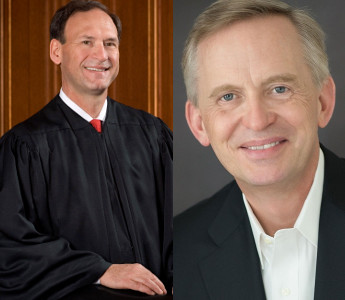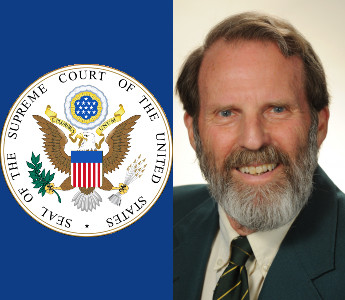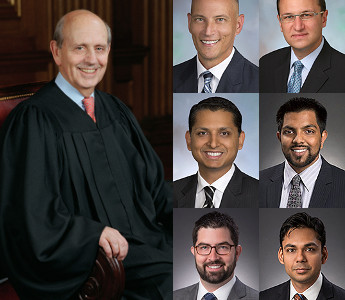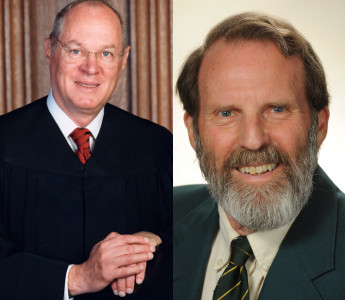Hughes v. Talen Energy Marketing, LLC, 578 U.S. ___ (2016) (Ginsburg, J.).
Response by Professor Emily Hammond
Geo. Wash. L. Rev. Docket (Oct. Term 2015)
Slip Opinion | SCOTUSblog
Energy Law’s Jurisdictional Boundaries – Take Three
The facts of the case involve the relationship between state efforts to incentivize new power plants and the federally regulated competitive electricity markets. The former have always been within state authority, while the latter fall under the jurisdiction of the Federal Energy Regulatory Commission (FERC) pursuant to the Federal Power Act (FPA).4 This state-federal divide, however, is not nearly so neat in practice. Here, Maryland wanted new natural gas generation within its borders. But the wholesale capacity markets—operated according to FERC-approved rules and meant to incentivize new construction if needed on a regional basis—was not providing sufficient price signals to encourage the new construction for which Maryland hoped. Thus, Maryland enacted a statute to subsidize a new natural gas plant by making up the difference between the capacity market clearing price and what the new natural gas plant needed to attract investors.5
All eight Justices agreed that Maryland’s scheme is preempted by the FPA; Justices Sotomayor and Thomas concurred to emphasize the narrowness of the holding.6 Indeed, the Court’s jurisprudential approach was carefully cabined, sticking closely to the FPA itself rather than self-consciously delving into the preemption doctrines generally.7 The Court grounded its reasoning in the language of the FPA and standard Supremacy Clause decisions arising under that statute—for example, Mississippi Power & Light Co. v. Mississippi ex rel. Moore,8 which stands for the proposition that states may not independently assess FERC-approved wholesale rates for in-state utility cost-recovery purposes.9 It was not a stretch for the Court to conclude that Maryland had undertaken a similarly prohibited activity. By pegging the new natural gas plant’s revenue to the capacity clearing price such that the plant could obtain revenue different from that clearing price, Maryland had overtly interfered with FERC’s authority.10
In a closing paragraph, the Court again emphasized the narrowness of its holding. The relevant passage, which is sure to be dissected by future state policymakers and prospective litigants alike, provides:
We therefore need not and do not address the permissibility of various other measures States might employ to encourage development of new or clean generation, including tax incentives, land grants, direct subsidies, construction of state-owned facilities, or re-regulation of the energy sector.11
Why does this passage matter so much? Because cost is captured on wholesale markets, but reliability and environmental attributes are not.12 As states consider how to improve the reliability of the power grid and capture the benefits of clean energy resources, they are increasingly going to confront the wholesale markets’ deficiencies in these regards. What is more, whether a state has restructured may have a profound impact on its spectrum of acceptable options after Hughes.13
Consider current state efforts to preserve existing nuclear power plants.14 In traditionally regulated states, utility commissions are required to allow utilities to recover wholesale purchase costs—see Mississippi Power & Light—and further set just and reasonable rates that allow the utilities to earn a reasonable rate of return.15 But in restructured states with merchant nuclear generators, those power plants are struggling to stay in business because the market clearing prices do not cover long-run average costs.16 The reasoning of Hughes suggests that restructured states operating in organized wholesale markets may not build additional compensation into schemes that are expressly linked to a need for some amount of income over the wholesale clearing price. More generalized options, such as tax breaks, are likely to attract political opposition, making it very difficult for these states to achieve their specific policy goals.
The difficulty is that Hughes doesn’t really tell us which state initiatives will survive future Supremacy Clause challenges and which will fail. We are likely now in the position of awaiting “Take Four.”
Professor Hammond would like to thank Joel Eisen for his helpful comments.
- FERC v. Elec. Power Supply Ass’n, 136 S. Ct. 760 (Jan. 25, 2016); ONEOK, Inc. v. Learjet, Inc., 135 S. Ct. 1591 (2015). I have previously responded to those opinions. See Emily Hammond, Response, Energy Law’s Jurisdictional Boundaries: Staying the Course, Geo. Wash. L. Rev. Docket (Jan. 30, 2016), http://www.gwlr.org/ferc-v-electric-power-supply-assosciation-energy-laws-jurisdictional-boundaries-staying-the-course/; Emily Hammond, Response, Energy Law’s Jurisdictional Boundaries: A Call for Course Correction, Geo. Wash. L. Rev. Docket (Apr. 28, 2015), http://www.gwlr.org/oneok-v-learjet/.
- Hughes v. Talen Energy Marketing, LLC, No. 14-614 (U.S. Apr. 19, 2016).
- For a prediction of this result, see Joel B. Eisen, FERC v. EPSA and the Path to a Cleaner Electricity Sector, 40 Harv. Envtl. L. Rev. Forum 1, 10 (2016).
- Federal Power Act, 16 U.S.C. §§ 791a–828 (2012).
- This description is considerably oversimplified. For helpful hypotheticals, see Hughes, slip op. at 8 n.5.
- Hughes, slip. op. at 1 (Sotomayor, J., concurring), Hughes, slip. op. at 1 (Thomas, J., concurring).
- The ONEOK decision rests on field preemption grounds. 135 S. Ct. at 1595. Arguably, the Court engaged in a conflict analysis as a functional matter, notwithstanding its disavowal of such an approach. Cf. Hines v. Davidowitz, 312 U.S. 52 (1941) (courts must consider whether state law “stands as an obstacle to the accomplishment and execution of the full purposes and objectives of Congress”).
- Miss. Power & Light Co. v. Miss. ex rel. Moore, 487 U.S. 354 (1988).
- Id. at 371 (describing “fundamental principles concerning the preemptive impact of federal jurisdiction over wholesale rates on state regulation”).
- Hughes, slip op. at 14.
- Id. at 15.
- For a full discussion, see Emily Hammond & David B. Spence, The Regulatory Contract in the Marketplace, 69 Vand. L. Rev. 141 (2016).
- See id. at 209 (elaborating this point).
- Ohio, New York, and Illinois are currently considering such policy options. This response does not analyze or opine on any specific options.
- See, e.g., Fed. Power Comm’n v. Hope Nat. Gas Co., 320 U.S. 591, 602–03 (1944).
- Hammond & Spence, supra note 12, at 190.
Recommended Citation
Emily Hammond, Response, Hughes v. Talen Energy Marketing, LLC, Geo. Wash. L. Rev. Docket (Apr. 22, 2016), http://www.gwlr.org/hughes-v-talen-energy-marketing-llc-energy-laws-jurisdictional-boundaries-take-three.





